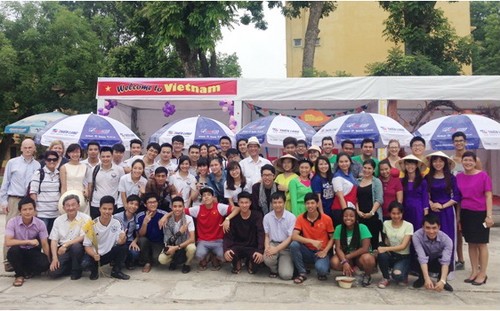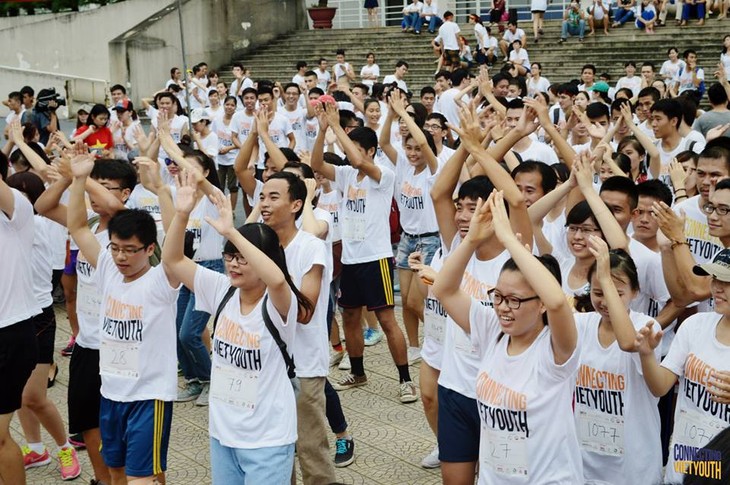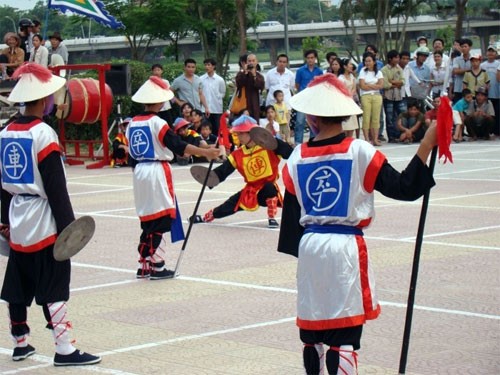(VOVworld)
- A number of youth festivals have been and will be held in many localities in Vietnam involving a large number of young people from many countries. These activities have drawn the interest of our listeners who want to know whether students from their country participated.
B: Indian listener S.B Sharma listened to a news item on the 2015 International Summer Camp in Thai Nguyen province on June 22 which was part of activities celebrating the 20th anniversary of the normalization of diplomatic relations between Vietnam and the US. He wrote: “We are happy to learn of the normalized relationship between Vietnam and the US. There were students from the US, Thailand, the Philippines, and Vietnam. I wish more foreign students could participate in this event. How many countries participated? Have Indian students ever participated in this camp? How are students selected for the Vietnam summer camp?”
 |
Foreign and Vietnamese students attend the International Summer Camp in Thai Nguyen
|
A: This summer camp is not an annual event. It was organized to mark the 20th anniversary of the normalization of Vietnam-US relations, so the number of foreign participants was limited. The highlight of the program was a music night featuring Thao & The Get Down Stay Down Band. Thao and The Get Down Stay Down is a San Francisco, California-based alternative rock group. It consists of Vietnamese-American Thao Nguyen - vocals and guitar, Adam Thompson - vocals, bass guitar, and keyboards, Frank Stewart - lead guitar, and production, and Willis Thompson - drums.
 |
Thao & The Get Down Stay Down
|
B: Students from the US, Thailand, the Philippines, and foreign students studying at Thai Nguyen University also performed. Participants visited scenic spots and historical sites such as Nui Coc lake and the Cultural Museum of Vietnam’s ethnic groups.
A: The Vietnam Summer Camp for young overseas Vietnamese is an important annual event of hundreds of participants. Held by the State Committee for Overseas Vietnamese Affairs, this year’s Vietnam Summer Camp themed “Proud of Vietnam” runs from July 13 to July 31, taking 160 participants to major landmarks throughout Vietnam. Most of the participants, between the ages of 16 and 25, are students with outstanding academic achievements, sports, and cultural achievements, and community contributions. They come from 21 countries in Asia, Europe, and America.

Young overseas Vietnamese visit Hung Temple during the 2015 Vietnam Summer Camp |
B: During the program, they joined in various activities to improve their understanding of their homeland’s history, culture, and contemporary life. On July 15, they paid tribute to the Hung Kings, the legendary founders of the first regime in Vietnam’s history, in northern Phu Tho province. Yesterday they arrived in Hue, an ASEAN City of Culture, to explore the Khai Dinh royal tomb, Thien Mu pagoda – the oldest pagoda in Hue – and Hue’s ancient Imperial Citadel. Information about the event, including contact and registration information, and a description of activities, is available on the website http://traihevietnam.vn.
A: Another event for young people is Connecting VietYouth 2015 (CVY) which will begin with a charity run called the CVY Innovation Marathon on July 25 at Hang Day Stadium in Hanoi. Prizes worth 23,200 USD are expected to attract more than 1,500 people, including foreign students from the UK, France, Switzerland, the US, Australia, and Singapore. The event’s proceeds will purchase books and stationery for underprivileged students in northern mountainous provinces and fund an event celebrating the Mid-Autumn Festival for child patients at Hanoi’s Institute of Haematology and Blood Transfusion.
 |
| Students joined CVY 2014 |
B: CVY 2015 is sponsored by the Global Shapers Community, the Vietnamese Students Association in the UK and the Vietnamese Youth and Student Association in the US. Students who are interested in the exchanges can contact these organizations.
A: Many of our listeners are teachers. I think you’ll be interested in these exchanges and should introduce them to your students. I’m reading a letter from Fumito Hokamura of Japan who listens to VOV’s programs in both Japanese and English. He says he can understand VOV’s news bulletins, but some programs are quite difficult to understand. Fumito said he likes Vietnamese pop and folk songs. Japanese folk songs are his favorite but not J-pop. He wants to find a place selling Vietnamese music CDs in Fukuoka.
B: To tide you over until you find a shop near you selling Vietnamese CDs, we’ll send you a CD of Vietnamese folk music.
A: Some of our listeners want to know about Vietnam’s national game. Well, we don’t officially acknowledge any game as our national game. Football, table tennis, badminton, Chinese chess, and martial arts are all popular recreations that young and old enjoy at parks, public playgrounds, office and school yards, and often on any available stretch of sidewalk.
 |
| A human chess match |
B: We’ll mention several folk games that are popular at village or temple festivals. “Human chess” is a variant of Chinese chess, in which people assume the roles of the 32 chess pieces - king, knight, bishop and so on. Typically, one side has 16 boys and the other has 16 girls. Each team wears a different colour. A match is usually played on an outdoor field, maybe in front of a communal house. When a piece is captured, the players enact a choreographed fight.
 |
A: Swings have been a traditional recreation at village festivals for centuries. They are most popular in the provinces of the northern delta. Villagers build their swings on a dry, harvested rice paddy near a communal house. The area should be large enough to allow spectators to stand around. The most common Vietnamese swings to allow a wooden platform, not a seat. One or two people stand on the platform and swing themselves high in the air, even tens of meters, until their bodies are almost parallel to the ground. Their goal is a prize hanging from the top of the swing's frame. Often a boy and a girl will swing together.
B: Wrestling is a traditional exhibition of the martial spirit. Wrestlers sit around a "carpet" which is an arena without ring or rope. The audience sits in a circle about 10m from the carpet. As with most traditional Vietnamese sports, drums or gongs, or both, accompany the wrestling to stimulate the athletes.
 |
Wrestling is a popular folk games at village festival
|
A: The beating of the drum sets the pace of the fight. The rhythm accelerates as soon as one of the wrestlers initiates a hold and returns to normal once the danger has passed, giving the wrestlers time to recover. When a wrestler falls, the rhythm accelerates, becoming more and more insistent. A finishing stroke of the drum puts an end to the combat when the loser's shoulders touch the ground. The winner and loser stand up, applauded by a prolonged drum roll. Other folk games played at festivals include tug-of-war, pushing sticks, running and cooking rice, and cock fighting.
B: Remember that you can listen to this program again on our website at www.vovworld.vn. Please send your feedback to: English section, Overseas Service, Radio Voice of Vietnam, 45 Ba Trieu Street, Hanoi, Vietnam. Our email address is englishsection@vov.org.vn. Good bye until next time.